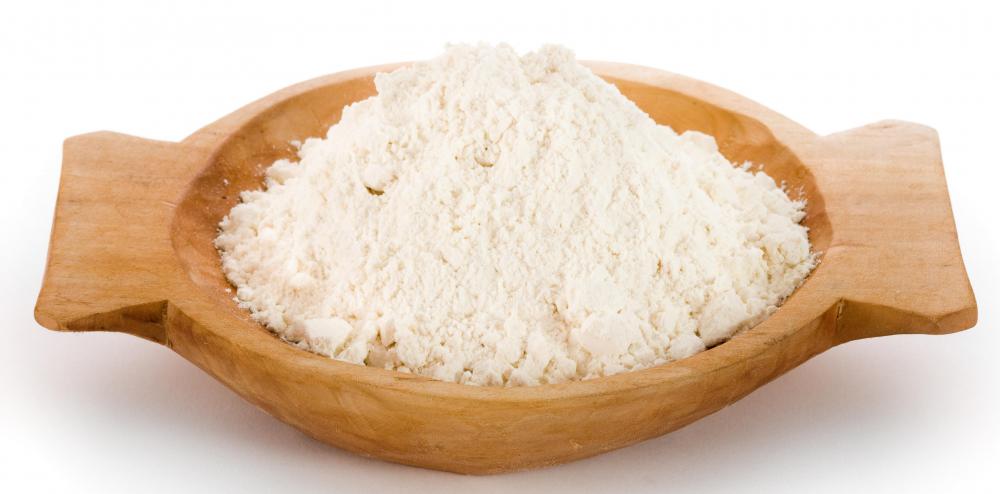At DelightedCooking, we're committed to delivering accurate, trustworthy information. Our expert-authored content is rigorously fact-checked and sourced from credible authorities. Discover how we uphold the highest standards in providing you with reliable knowledge.
What Are the Best Tips for Using Potato Flour?
Potato flour not only provides soups, stews, and gravies with a fast, effective thickening agent, but those who eat it with ample nutrition. Unlike potato starch, potato flour is derived from dried and powdered potatoes, typically ensuring that it is full of protein and iron. In addition to thickening dishes, it makes dense, tasty food coatings or batters and can also be used in baking bread. When replacing white flour with potato flour, one must remember to use plenty of liquid. This dried potato powder also only mixes well with cold fluids.
The heavy starches in potato flour usually make it excellent for thickening soups and stews. The usual recipe for this includes equal parts potato flour and cold water stirred together until they form a slurry, or thin paste similar to white glue. This slurry can then be mixed into any dish containing a sauce or broth. Cooks that try to mix the potato flour directly into food may find that the flour will only clump and refuse to distribute evenly. This happens because warm fluids often cause the flour to seize, or clump together.

The same rules apply when breading chicken, fish, meat, or vegetables. The eggs and milk used to bind the potato flour to these foods must be cold, otherwise the flour will clump and seize. Leaving the binding ingredients in the refrigerator until they are needed works well because they’ll still be cold when one whisks them together. Once this flour batter is stuck to the food, it may typically be fried or baked without trouble because it has already mixed with the cold liquids.

Baking bread from this flour can be quite tricky, even for some experienced bakers. It absorbs much more liquid than ordinary white flour and requires additional moisture to bake into soft, light bread products. Even if one does add the proper amount of liquid, the end results is often slightly denser and heavier than ordinary bread.
Successfully baking with potato flour may require that the baker add a few different types of moisture. Adding an additional half-part each of the wet ingredients may do the trick. For instance, if a recipe calls for water 1 cup (237 ml) of water, 1 tablespoon (15 ml) of butter and 1/2 cup (about 118 ml) of yogurt — a cook could mix in an additional 1/2 cup (about 118 ml) of water, 1/2 tablespoon (about 7 ml) of butter and 1/4 cup (about 60 ml) of yogurt to produce the right consistency. Since the potato flour can’t fully absorb the denser fats, these can help ensure the bread does not become too dry.
AS FEATURED ON:
AS FEATURED ON:














Discussion Comments
@ysmina-- I agree with you about the taste, but like you said, you get used to it in time. I personally think that potato flour is a lot healthier than regular white flour. And it's also great that it's suitable for gluten-free cooking.
Something else you can add to get rid of the potato taste, especially if you're making cookies or muffins is to add some applesauce in the dough. It makes the dough softer because it adds moisture and it also takes away the potato taste a little bit.
This is not much of a problem if you're adding just a little bit of potato flour to make soups and gravies thicker. It actually works perfectly this way.
@ysmina-- You're right. Potato flour even clumps with cold water sometimes! It's not like potato starch flour which mixes easily without effort and has no flavor.
Most people hate cooking with potato flour and rightly so! It's not a very easy flour to work with and it definitely takes practice to get it right. I must have tried baking with potato flour seven or eight times before getting a perfect result.
One thing I have noticed however is that adding cold water very slowly prevents clumping to a large extent. What I do is add a little bit of water, mix with the flour, add a little more, mix some more and on an on until all the water has been added.
I'm allergic to gluten and have to eat gluten-free flour. Potato flour has become a saver for me because I love pastries and I don't want to avoid them.
When I first started baking with potato flour, I made the common mistake of adding warm water to make the dough. That's what my mom always does with wheat flour because warm water makes the dough a lot softer. Not the case with potato flour at all! It really does clump badly and does not come out in a uniform texture.
It's also true that you need to add more water when making dough with potato flour. Even if it seems okay before baking. Baking seems to take all the moisture out of it and you get a very hard pastry or bread. So add extra water just to make sure.
The other suggestion I would make is to add seasonings to the dough if you're making bread and vanilla, cocoa or something similar if it's desserts. The reason is that potato flour tastes just like potatoes. It takes some getting used to the taste. I'm still trying to adjust but adding seasonings definitely helps.
Post your comments